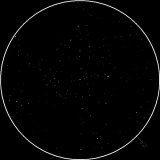
| MESSIER 35 |
|---|
RA: |
06h 08m 12s |
|
DEC: |
+24° 22' 00'' |
|
Type: |
Open Cluster |
|
NGC: |
2168 |
|
Magnitude: |
5.10 |
|
Surface brightness : |
||
Apparent dimensions : |
28'x28' |
|
Distance: |
2,800 ly |
|
Open star cluster M35 is consisted of several hundred stars (of which Wallenquist has counted 120 brighter than mag 13) scattered over the area covered by the full Moon. At its distance of 2,700 or 2,800 light years, this corresponds to a linear diameter of about 24 light years; its central density is about 6.21 stars per cubic parsec. With about 100 million years, it is of intermediate age, and contains some post-main sequence stars (including several yellow and orange giants of spectral type late G to early K). Its hottest main sequence star is given as of spectral class B3, and its Trumpler classification as III,3,r by all sources. It is approaching us at 5 km/sec. The discovery of M35 is usually assigned to Philippe Loys de Chéseaux who observed and cataloged it in 1745 or 1746. It is also printed in John Bevis' Uranographia Britannica which was completed in 1750, so that this astronomer must have discovered it independently before this time, maybe or maybe not before De Chéseaux. Charles Messier, who cataloged it on August 30, 1764, acknowledges Bevis' discovery. Even the naked eye finds this cluster easily near the 3 "foot stars" of Gemini under fairly good observing conditions. The slightest optical instrument will resolve the brighter stars and make it a splendid view at low magnifications, a nearly circular cluster with rather uniform stellar distribution. In telescopes, low powers and wide-field eye pieces show M35 at its best. Amateurs with more powerful telescopes can view its fainter neighbor, NGC 2158, it is situated just about 15 arc minutes southwest of M35. NGC 2158, of about mag 8.6 and about 5 arc minutes angular diameter, contains many more stars, is much more compact, over 10 times older and over five times more remote than M35, and because it consists of older stars, its light is dominated by yellower stars; the fottest star is of spectral type F0. Because of these properties, NGC 2158 was once even taken for a globular cluster candidate. |
||
VEDRAN VRHOVAC© 2006.-2007. |
